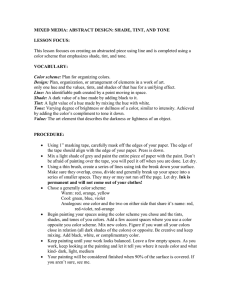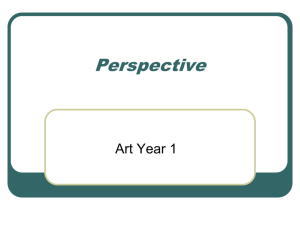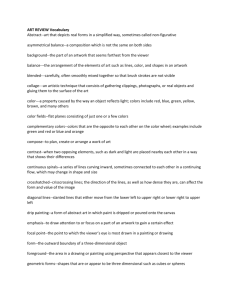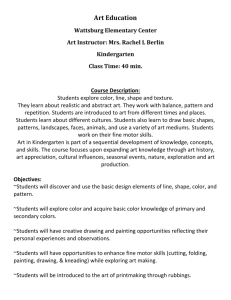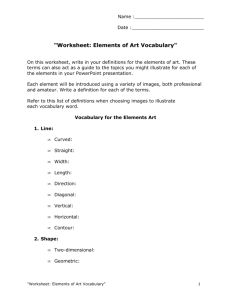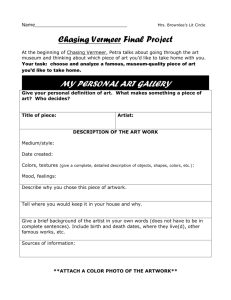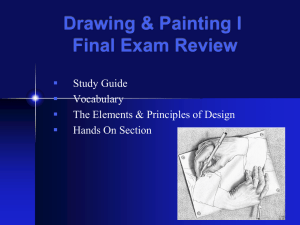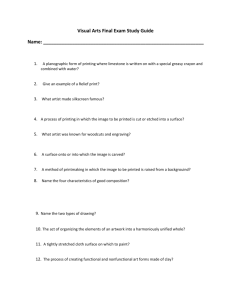Art 1- Midterm Exam Study Guide
advertisement
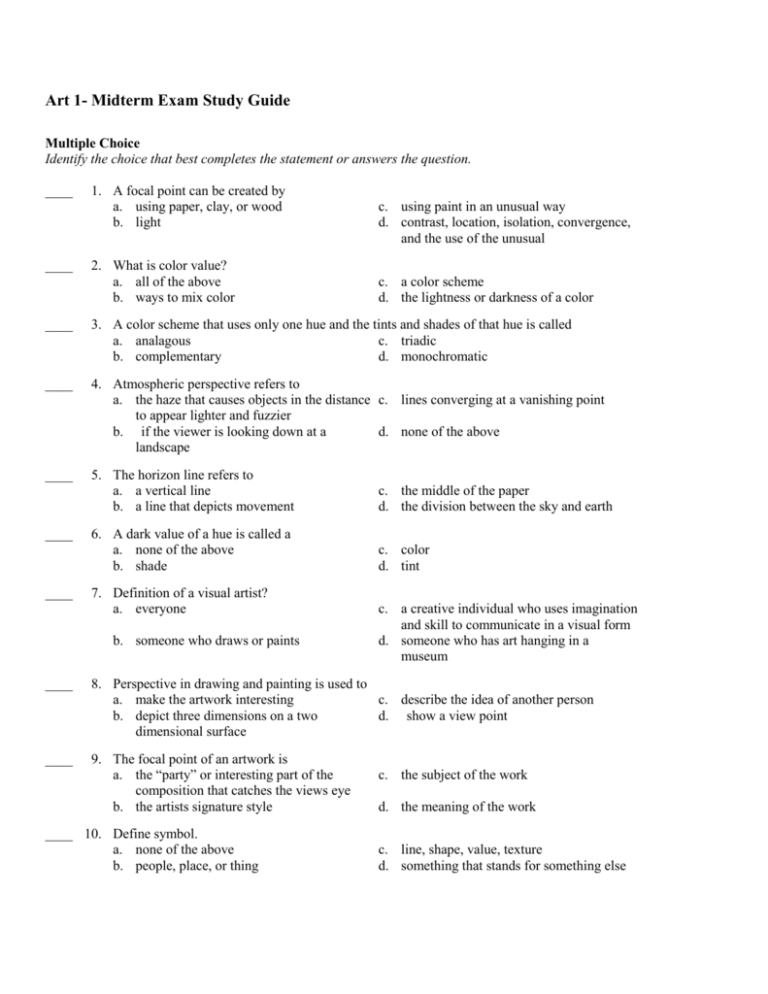
Art 1- Midterm Exam Study Guide Multiple Choice Identify the choice that best completes the statement or answers the question. ____ ____ 1. A focal point can be created by a. using paper, clay, or wood b. light 2. What is color value? a. all of the above b. ways to mix color c. using paint in an unusual way d. contrast, location, isolation, convergence, and the use of the unusual c. a color scheme d. the lightness or darkness of a color ____ 3. A color scheme that uses only one hue and the tints and shades of that hue is called a. analagous c. triadic b. complementary d. monochromatic ____ 4. Atmospheric perspective refers to a. the haze that causes objects in the distance c. lines converging at a vanishing point to appear lighter and fuzzier b. if the viewer is looking down at a d. none of the above landscape ____ 5. The horizon line refers to a. a vertical line b. a line that depicts movement c. the middle of the paper d. the division between the sky and earth 6. A dark value of a hue is called a a. none of the above b. shade c. color d. tint ____ ____ 7. Definition of a visual artist? a. everyone b. someone who draws or paints c. a creative individual who uses imagination and skill to communicate in a visual form d. someone who has art hanging in a museum ____ 8. Perspective in drawing and painting is used to a. make the artwork interesting c. describe the idea of another person b. depict three dimensions on a two d. show a view point dimensional surface ____ 9. The focal point of an artwork is a. the “party” or interesting part of the composition that catches the views eye b. the artists signature style ____ 10. Define symbol. a. none of the above b. people, place, or thing c. the subject of the work d. the meaning of the work c. line, shape, value, texture d. something that stands for something else ____ 11. A vanitas type of still life refers to a. all of the above b. a still life that includes decaying food c. a still life that represents mortality d. a still life that includes a skull or bones ____ 12. The brightness or dullness of a hue refers to this characteristic of color? a. intensity c. value b. shade d. tint ____ 13. _______________ is the part of the picture plane that appears closet to the viewer and is usually located at the bottom of the page. a. Foreground c. Background b. Focal Point d. Middle ground ____ 14. What is a landscape? a. a painting/drawing of a person b. a painting/drawing in which natural land scenery, such as mountains, trees, rivers, or lakes, is the main feature ____ 15. The following artist is NOT a surrealist artist a. Joan Miro b. Rene Magritte c. a painting/drawing of inanimate objects d. none of the above c. Vincent VanGogh d. Salivador Dali ____ 16. A light value of a hue, usually created by adding white, is called a a. color c. value b. texture d. tint ____ 17. Trompe l’Oeil means a. abstract b. to draw c. trick of the eye d. landscape ____ 18. The following is a technique artists use to show space on a 2-D surface a. size c. placement b. all of the above d. overlapping ____ 19. Which artist legitimized watercolor landscape paintings? a. Pablo Picasso c. Janet Fish b. Winslow Homer d. Dale Chihuly ____ 20. The orthogonal lines in perspective converge at a. the horizon line c. the pencil b. the drawing d. the vanishing point ____ 21. The secondary colors are a. brown, white, black, and gray b. red, yellow, and blue c. red, red- yellow, yellow d. orange, purple, and green ____ 22. What is art? a. the creation of something beautiful used to c. everything around us express feeling or decoration b. a painting or drawing d. the visual expression of an idea or experience created with skill ____ 23. How do visual artists illustrate space on a 2-D surface? a. all of the above c. placement b. color and detail d. size ____ 24. The image a viewer can easily recognize in a work of art? a. content c. symbol b. composition d. subject ____ 25. A Surrealist artwork is characterized by one of the following techniques a. metamorphasis c. transparency b. all of the above d. levitation, juxtaposition, scale ____ 26. Colors opposite each other on the color wheel are referred to as a. primary c. complementary b. opposite d. secondary ____ 27. The still life genre refers to a. paintings/sculpture of people b. artwork depicting inanimate (non-living) objects c. paintings of the outdoors d. paintings of animals ____ 28. A color scheme that uses hues that are next to each other on the color wheel is referred to as a. analagous c. monochromatic b. complementary d. triadic ____ 29. The vanishing point refers to a. where the sky meets the earth b. the content of the artwork c. point on the horizon where receding parallel lines seem to meet d. none of the above Short Answer 30. What two colors are mixed to create purple? 31. Name the area of a landscape that looks as if it is the furtherest from the viewer and is located at the top of the page. 32. What two colors are mixed to create green? 33. Name 3 colors that could be used in an analogous color scheme. 34. Name the primary colors. 35. Draw 3 geometric shapes. 36. What two colors are mixed to create orange? 37. What types of colors are mixed to create intermediate/tertiary colors? 38. Draw 3 organic shapes. Completion Complete each statement. 39. Draw a cylinder and shade. Shade so that the light source is coming from the top left of the cylinder. Don’t forget to create the cast shadow. 40. Draw a square, a rectangle, and a square in 1 point perspective. Start with a horizon line and indicate your vanishing point with an x.
